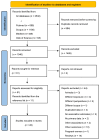Acrylamide Exposure and Cardiovascular Risk: A Systematic Review
- PMID: 39770901
- PMCID: PMC11677207
- DOI: 10.3390/nu16244279
Acrylamide Exposure and Cardiovascular Risk: A Systematic Review
Abstract
Background/Objectives: Acrylamide is a food contaminant formed during high-temperature cooking processes, leading to unintentional human exposure. Diet is the primary source for non-smokers, with potatoes, cereals, and coffee being the main contributors. While animal studies have demonstrated that acrylamide is neurotoxic, genotoxic, mutagenic, and cardiotoxic, its effects on human cardiovascular health remain poorly understood. This study aimed to evaluate the association between acrylamide exposure and cardiovascular risk. Methods: A comprehensive literature search was conducted across four databases without restrictions on publication year or language (last search: 1 July 2024). The risk of bias was assessed using the Joanna Briggs Institute critical appraisal tools. Results: In total, 28 studies were included, predominantly from the US NHANES sample and with cross-sectional designs. Higher acrylamide exposure was associated with an increased risk of cardiovascular mortality but was inversely associated with glucose and lipid levels, as well as key cardiovascular risk factors such as diabetes, obesity, and metabolic syndrome. Conversely, glycidamide-acrylamide's most reactive metabolite-was positively associated with elevated glucose and lipid levels, higher systolic blood pressure, and increased obesity prevalence. Conclusions: These findings suggest that the adverse cardiovascular effects of acrylamide may be mediated by its conversion to glycidamide. Further research is necessary to fully elucidate the impact of acrylamide on cardiovascular health. Meanwhile, public health efforts should continue to focus on mitigation strategies within the food industry and raising public awareness about exposure.
Keywords: acrylamide; cardiovascular; diabetes; lipids; morality; obesity.
Conflict of interest statement
The authors have no competing interests to declare that are relevant to the content of this article.
Figures



Similar articles
-
Effects of a gluten-reduced or gluten-free diet for the primary prevention of cardiovascular disease.Cochrane Database Syst Rev. 2022 Feb 24;2(2):CD013556. doi: 10.1002/14651858.CD013556.pub2. Cochrane Database Syst Rev. 2022. PMID: 35199850 Free PMC article.
-
Dietary Approaches to Stop Hypertension (DASH) for the primary and secondary prevention of cardiovascular diseases.Cochrane Database Syst Rev. 2025 May 6;5(5):CD013729. doi: 10.1002/14651858.CD013729.pub2. Cochrane Database Syst Rev. 2025. PMID: 40326569 Review.
-
Health professionals' experience of teamwork education in acute hospital settings: a systematic review of qualitative literature.JBI Database System Rev Implement Rep. 2016 Apr;14(4):96-137. doi: 10.11124/JBISRIR-2016-1843. JBI Database System Rev Implement Rep. 2016. PMID: 27532314
-
Eliciting adverse effects data from participants in clinical trials.Cochrane Database Syst Rev. 2018 Jan 16;1(1):MR000039. doi: 10.1002/14651858.MR000039.pub2. Cochrane Database Syst Rev. 2018. PMID: 29372930 Free PMC article.
-
Home treatment for mental health problems: a systematic review.Health Technol Assess. 2001;5(15):1-139. doi: 10.3310/hta5150. Health Technol Assess. 2001. PMID: 11532236
References
-
- Substance Information—ECHA. [(accessed on 31 July 2024)]. Available online: https://echa.europa.eu/es/substance-information/-/substanceinfo/100.001.067.
-
- Petersen B.J., Tran N. Chemistry and Safety of Acrylamide in Food. Springer; Boston, MA, USA: 2005. Exposure to Acrylamide; pp. 63–76. - DOI
Publication types
MeSH terms
Substances
Grants and funding
LinkOut - more resources
Full Text Sources

